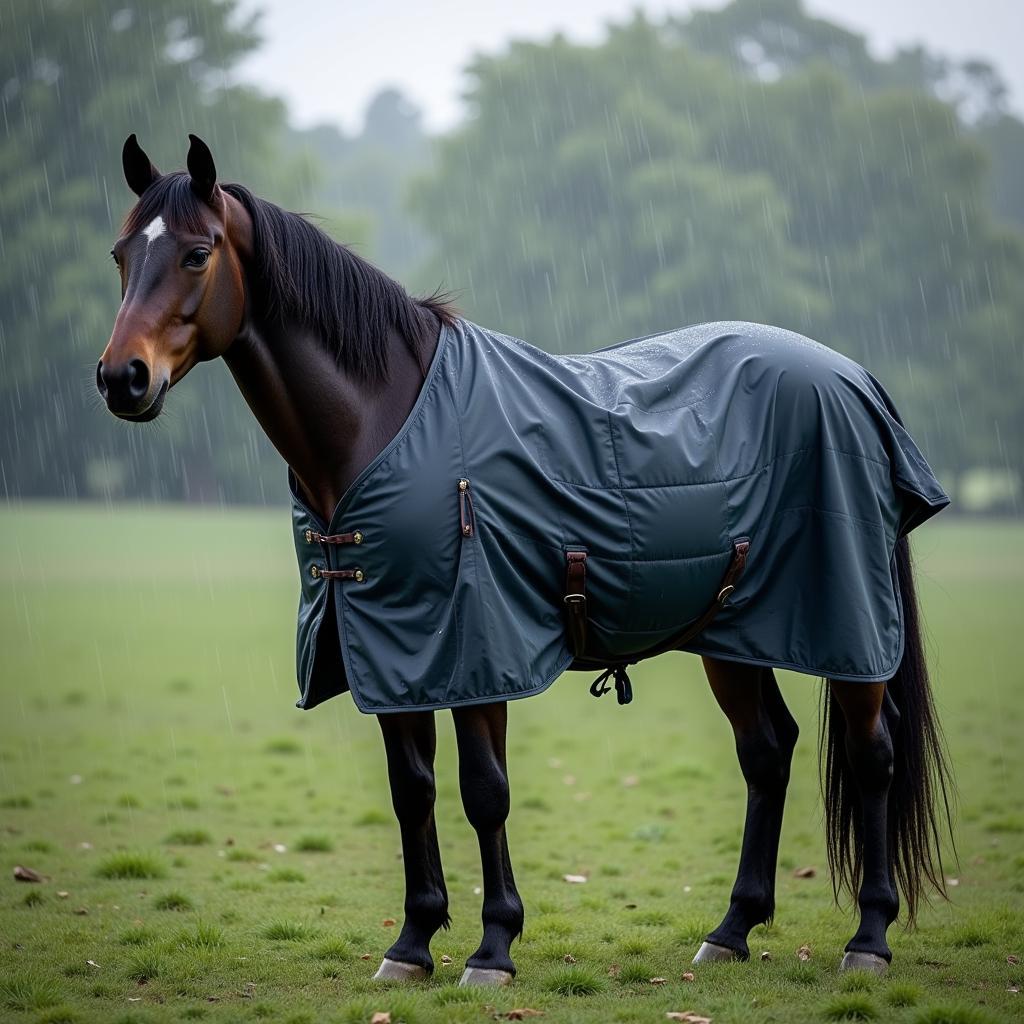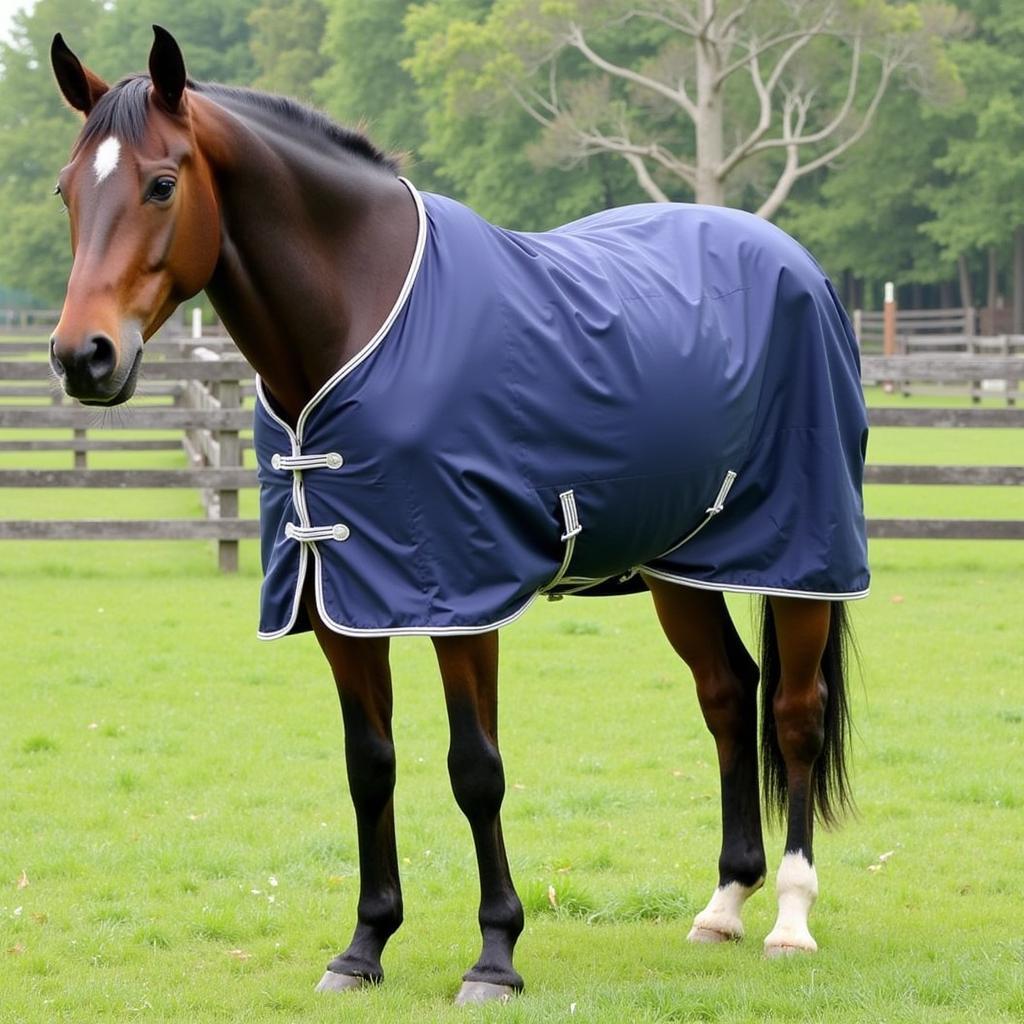Can You Blanket A Wet Horse? It’s a question many horse owners grapple with, especially during unpredictable weather. The simple answer isn’t always so simple, as blanketing a wet horse can be both beneficial and detrimental, depending on the circumstances. Understanding the intricacies of horse temperature regulation, the types of blankets available, and the potential risks involved is crucial for making the best decision for your equine companion.
When is Blanketing a Wet Horse Okay?
Sometimes, blanketing a wet horse is not only acceptable but also the best course of action. If your horse is drenched in cold rain and shivering, a blanket can help prevent hypothermia. In this situation, the priority is to dry the horse as quickly as possible. Use a waterproof rain sheet for horses to prevent further chilling while wicking away moisture. A good quality rain sheet is essential for any horse owner.
A lightweight, moisture-wicking blanket can be helpful if your horse is damp from sweat after a workout in cooler weather. This helps prevent the horse from catching a chill as the sweat evaporates. The key here is choosing the right type of blanket – something breathable that will allow the moisture to escape while still providing warmth.
 Wet Horse in Rain Needs Blanket
Wet Horse in Rain Needs Blanket
The Dangers of Blanketing a Wet Horse
While blanketing a wet horse can be beneficial in certain circumstances, it also presents some risks. Blanketing a horse that is soaked to the skin and muddy can trap moisture against the coat, creating a perfect breeding ground for bacteria and fungi. This can lead to skin irritations, rain rot, and other infections.
Another danger is overheating. Even if a horse is wet, a heavy blanket can trap heat and raise the horse’s body temperature, leading to discomfort and potential health issues. This is especially true if the horse is still slightly damp and the blanket is not breathable. Choosing the right blanket, like a defender horse blanket, is vital for your horse’s well-being.
What to Do with a Wet Horse
So, what’s the best approach when dealing with a wet horse? The first step is to assess the situation. How wet is the horse? What is the temperature and weather forecast? Is the horse shivering? Is the horse sweaty or drenched in rainwater? These factors will determine the appropriate course of action.
If the horse is only slightly damp and the weather is mild, you may not need a blanket at all. Allowing the horse to air dry naturally is often the best option. However, if the horse is soaked and the weather is cold, you need to act quickly.
The ideal scenario is to dry the horse thoroughly before blanketing. Use towels or a cooler to wick away as much moisture as possible, especially from areas like the legs, neck, and back. If you have access to a stable with good ventilation, this is the best place to dry the horse. Once the horse is relatively dry, you can apply a lightweight, breathable blanket like the Kentucky horse blankets for added warmth and comfort.
Choosing the Right Blanket for a Wet Horse
The type of blanket you choose is crucial. Avoid using stable blankets made from horse fabric cotton for a wet horse. Opt for a waterproof and breathable turnout blanket or a rain sheet specifically designed to wick away moisture. There are many different types of blankets on the market, so it’s essential to choose one that suits your horse’s individual needs.
“A common mistake is using a thick, non-breathable blanket on a wet horse,” says Dr. Emily Carter, DVM. “This can trap moisture and lead to skin problems. Always prioritize breathability when blanketing a wet horse.”
Caring for Your Horse’s Coat
Regular grooming is essential for maintaining a healthy coat, which plays a crucial role in thermoregulation. Using a horse whitening shampoo can help keep the coat clean and free of dirt and debris that can contribute to skin issues.
“A healthy coat is a horse’s first line of defense against the elements,” adds Dr. Carter. “Regular grooming and proper blanket management are essential for maintaining coat health and preventing skin problems.”
 Horse Wearing a Waterproof Blanket
Horse Wearing a Waterproof Blanket
Conclusion
Can you blanket a wet horse? The answer, as we’ve seen, depends on several factors. While blanketing can be beneficial in cold weather, it’s crucial to prioritize drying the horse first and using the right type of blanket. Understanding these principles will help ensure your horse stays comfortable, healthy, and protected from the elements.
FAQ
- What type of blanket is best for a wet horse? A waterproof and breathable turnout blanket or rain sheet.
- Should I blanket a horse that’s only slightly damp? Not necessarily; air drying is often sufficient.
- Can I use a stable blanket on a wet horse? No, stable blankets are not designed for wet conditions.
- What can happen if I blanket a soaking wet horse? It can trap moisture, leading to skin problems like rain rot.
- How can I dry my horse quickly? Towel dry thoroughly, focusing on the legs, neck, and back.
- What should I do if my horse is shivering in the rain? Immediately move the horse to a sheltered area and dry it as much as possible before applying a waterproof blanket.
- How can I prevent my horse’s blanket from rubbing? Ensure the blanket fits properly and use a liner if necessary.
For further assistance, feel free to explore other helpful articles on our website.
Need more help? Contact us! Phone: 0772127271, Email: [email protected] Or visit us at: QGM2+WX2, Vị Trung, Vị Thuỷ, Hậu Giang, Vietnam. We have a 24/7 customer support team.